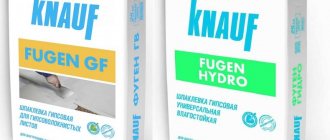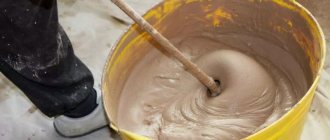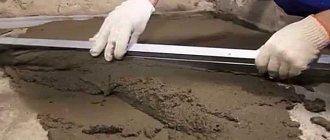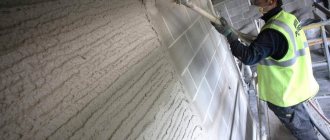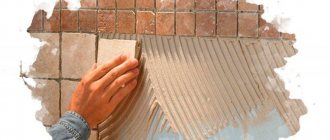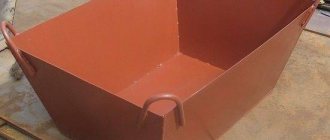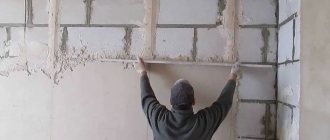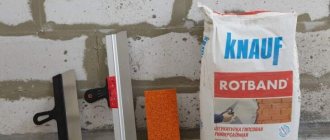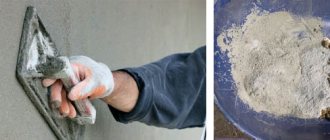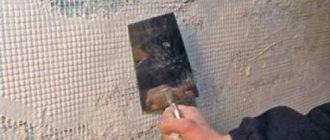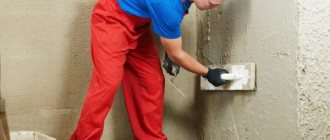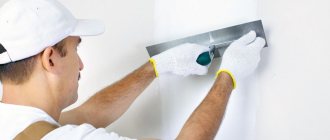Every builder-finisher knows well that the best quality when leveling walls can be achieved by using materials from the same manufacturer, adapted to each other, for all stages of work.
Unfortunately, not all manufacturers produce a full range of all necessary components and not all can boast of excellent product quality. But this does not apply to Knauf brand products - cement, gypsum, polymer plaster, primers, impregnations and other materials from this company deserve the highest rating.
In this article we will try to give a brief but detailed analysis of dry construction mixtures from Knauf, or more precisely, cement and gypsum plasters, with which you can solve many problems. These include: repair and sealing of cracks, rough and final leveling of bases, insulation, decorative finishing, etc.
Cement based plasters
Until recently, this brand in our country was represented mainly by gypsum materials, including dry mixes, drywall and components for it. Now Knauf cement plaster, available in several types, has also become widely known.
Unterputz
This is a dry cement mixture with fractionated sand and special additives that increase the plasticity of the material and the water-repellent ability of the coating. The solution prepared from it can be applied either manually or by machine.
Facade plaster Unterputz
Application area:
- For external work - plastering facades, creating bases for decorative coatings;
- For interior work - plastering walls in rooms with high air humidity (industrial premises, basements, laundries, etc.).
Plaster can be applied in layers from 10 mm to 20 mm, the total thickness of the multilayer coating can reach 35 mm. Consumption of dry mixture per 1 sq.m. with a layer thickness of 10 mm it is 17 kg.
In addition to water resistance, strength and ductility, the advantages of the material include the absence of shrinkage and the appearance of cracks when drying, and the possibility of thin-layer application.
Specifications:
| Characteristics | Magnitude |
| Water holding capacity | >98% |
| Grain | Up to 1.5 mm |
| Viability of solution | 1.5-2 hours |
| Frost resistance | >25 cycles |
| Adhesion strength | >0.4 MPa |
| Vapor permeability coefficient | >0.1 mg/(m*hour*Pa) |
| Compressive strength | >2.5 MPa |
Knauf cement plaster Unterputz is available in paper bags of 25 kg. Shelf life 1 year.
Grünband
In addition to cement and sand, this plaster contains various additives and lightweight filler in the form of polystyrene foam granules, which gives it thermal insulation properties. The solution can be applied either manually or by machine.
Thermal insulating plaster Grünband
Application area:
- For external work - plastering facades, creating bases for decorative coatings (ceramic tiles, artificial stone, Diamant Knauf plaster, etc.);
- For interior work - finishing ceilings and walls in wet rooms.
Note. The basis for application can be concrete, silicate and ceramic bricks, foam concrete, expanded clay concrete, aerated concrete blocks.
The permissible layer thickness is 10-30 mm. Consumption of dry mixture per 1 sq.m. with a layer thickness of 10 mm it is 12 kg.
Advantages of the material: good vapor permeability, thermal insulation properties, absence of cracks, ease of application, ability to protect walls from atmospheric influences.
Specifications:
| Characteristics | Magnitude |
| Water absorption | <15% |
| Grain | Up to 1.5 mm |
| Thermal conductivity | < 0.35 W/m°C |
| Frost resistance | >35 cycles |
| Density | 3 |
| Vapor permeability coefficient | >0.1 mg/(m*hour*Pa) |
| Compressive strength | >3.4 MPa |
| Adhesion strength | >0.4 MPa |
The release form for Knauf Grünband plaster is 25 kg paper bags. Shelf life 1 year.
Sockelputz
Particularly strong cement mixture with special additives and fractionated sand for manual and mechanized application.
Sockelputz base plaster
Application area:
- For external work – plastering of facades and plinths, including for subsequent decorative finishing;
- For interior work - plastering walls in rooms with high air humidity (industrial premises, basements, laundries, etc.).
Plaster can be applied in layers from 10 mm to 15 mm, the total thickness of the multilayer coating can reach 35 mm. Consumption of dry mixture per 1 sq.m. with a layer thickness of 10 mm it is 17 kg.
| Characteristics | Magnitude |
| Water holding capacity | >98% |
| Grain | Up to 1.5 mm |
| Viability of solution | 1.5-2 hours |
| Frost resistance | >25 cycles |
| Adhesion strength | >0.4 MPa |
| Vapor permeability coefficient | >0.1 mg/(m*hour*Pa) |
| Compressive strength | >7.5 MPa |
Sockelputz cement plaster is available in 25 kg paper bags. Shelf life 1 year.
Sevener
Dry plaster and adhesive mixture with fractionated sand, polymer additives and special fibers for do-it-yourself application.
Sevener plaster and adhesive mixture
Application area:
- Repair of old plaster on building facades;
- Gluing thermal insulating polystyrene foam or mineral wool boards to the base, as well as applying over insulation to create a protective layer with reinforcing fiberglass mesh;
- Installation of an intermediate adhesion layer on surfaces made of porous or smooth concrete.
Mixture consumption per 1 sq.m. depends on how the solution is used:
- For gluing insulating boards to masonry – 6 kg;
- For gluing insulating boards to a flat surface – 3.5 kg;
- For installing a protective layer of thermal insulation – 7 kg;
- For repairing old plaster with applying the mortar over a grid – 5-10 kg.
Knauf Sevener plasters, due to the presence of special fibers, adhesive and water-repellent additives in their composition, firmly adhere to the base, provide the masonry or insulation with reliable protection from getting wet, and the finished coating with increased strength and resistance to cracks.
Specifications:
| Characteristics | Magnitude |
| Water absorption | <15% |
| Grain | Up to 1.5 mm |
| Frost resistance | >75 cycles |
| Density | 1600 kg/m3 |
| Vapor permeability coefficient | >0.1 mg/(m*hour*Pa) |
| Compressive strength | >7.5 MPa |
Sevener cement plaster is available in 25 kg paper bags. Shelf life 1 year.
Adhesive
Cement plaster with quartz and limestone filler and chemical additives that increase the adhesive properties of the material. Apply by hand or machine.
Spray plaster Adhesive
Scope of application: for spraying concrete, silicate, rubble and old brick bases before applying leveling cement plasters to them.
Note. The adhesive improves the adhesion of materials, creating a rough surface, and strengthens the substrate. The instructions recommend using this plaster instead of metal reinforcing mesh when treating bases made of sand-lime brick and smooth concrete.
The photo shows the process of spraying brick walls.
The recommended layer thickness is 5 mm. The consumption of dry mixture per 1 sq.m is 5-8 kg.
Specifications:
| Characteristics | Magnitude |
| Water absorption | <15% |
| Grain | 0-4 mm |
| Frost resistance | >25 cycles |
| Density | 1600 kg/m3 |
| Vapor permeability coefficient | >0.1 mg/(m*hour*Pa) |
| Compressive strength | >7.5 MPa |
Cement plaster Adhesive is available in 25 kg paper bags. Shelf life 1 year.
Diamond
Decorative plaster Knauf Diamant is a cement mixture with mineral granules for application to concrete, gypsum and cement bases for the purpose of their decorative finishing. Forms a textured surface with a granular or grooved structure. Applied manually or mechanically.
The material is available in several colors:
- White;
- Citrus;
- Sahara;
- Light sugar;
- Emerald;
- Light emerald;
- Lapis lazuli;
- Light lapis lazuli.
Diamond plaster color samples
For reference. Diamant – white Knauf decorative plaster, if necessary, can be tinted to a different tone by adding appropriate pigments to the mixture.
Application area:
- For external work - decorative finishing of concrete bases and surfaces plastered with all the compounds listed above;
- For interior work - decorative finishing of plasterboard walls and walls plastered with Knauf gypsum compounds (Rotband, Goldband, MP 75).
The main advantages are resistance to adverse weather conditions and protection of surfaces from getting wet.
Textured plaster Diamond
Recommended layer thickness is 3-4 mm. The consumption of dry mixture per 1 sq.m is 3.8 kg.
Specifications:
| Characteristics | Magnitude |
| Water absorption | <15% |
| Grain | 3 mm |
| Frost resistance | 50 cycles |
| Density | 1770 kg/m3 |
| Vapor permeability coefficient | >0.1 mg/(m*hour*Pa) |
| Compressive strength | >3.5 MPa |
Packaging Knauf Diamant 260 decorative plaster – 25 kg in a paper bag (one bag is enough for 6.5 sq.m.). Shelf life 1 year.
Material consumption
Having chosen the material for repair work, you should calculate its required quantity.
The minimum layer of plaster composition is 1 cm, the maximum is 5 cm. These requirements must be observed to avoid the mixture from leaving the surface and destroying the composition.
Cement plaster has an average consumption of 1.5-1.8 kg. mixtures per 1 sq. m area of prepared coating.
- Gypsum, unlike cement, has a lower density level and therefore is more popular in the building materials market.
- If the walls or ceiling are well prepared in advance, the consumption of gypsum plaster will be about 1 kg. product per 1 sq. m. with a finishing thickness of 1 cm.
Knauf plaster is sold in bags, each containing 30 kg. dry mixture.
- Each package contains the manufacturer's recommendations regarding material consumption and the required amount of water for diluting the solution.
- To perform calculations, you need to find out which coating layer is needed in a particular case. To do this, you need to measure surface deviations, if any.
- For example, if it is 1 and 2 cm in different areas, then the required layer is calculated as follows: the data obtained are added up and divided by the number of measurements (1+2)/2=1.5 cm.
- Thus, the average layer of plaster will be 1.5 cm. For finishing 1 sq. m. you will need 15 kg of plaster, i.e. half a bag. For 10 sq. m. you will need to take 5 bags of dry composition.
For more detailed information, it is recommended to study the catalog of plaster in bags.
Gypsum compositions
Mixtures, a significant percentage of which is gypsum, are widely used in interior decoration of residential premises.
This is one of the most convenient options. When using Knauf products, the surface after plastering is ready for further finishing within a week. Brief description and prices for Knauf gypsum plasters
| Name | a brief description of | Thickness of one layer, mm | Consumption at 10 mm layer, kg per sq. m. | Packaging, kg | approximate price |
| Rotband | Universal, dry mix, unless otherwise noted | Wall: 5-50, ceiling: 5-15 | 8,5 | 25 | 300 rub. |
| 30 | 350 rub. | ||||
| 20 (paste) | 600 rub. | ||||
| Goldband | — | 8-50 | 8,5 | 30 | 360 rub. |
| MP 75 | Machine applied | Wall: 5-50, ceiling: 5-15 | 10 | 30 | 270 rub. |
| MN Start | 10-30 | 10 | 30 | 250 rub. | |
| HP Start | — | 10-30 | 10 | 25 | 240 rub. |
Almost all compositions that are marked “for machine application” can be used for manual work. But on the contrary - under no circumstances! This can lead to breakdown of expensive equipment with all the ensuing consequences.
Preliminary work
- Applying primer. The adhesive properties of the base plane can be increased by pre-priming it. Walls made of different materials have their own approaches. Thus, walls made of cellular concrete and brick (materials that strongly absorb water) are primed with Grundirmittel (consumption 0.1-0.15 kg/m2) or Grund (consumption 0.4 kg/m2), which dry in about 6 hours. This is done to prevent water from the plaster from being absorbed into the wall, which prevents it from setting prematurely and unevenly. As for concrete surfaces or walls insulated with EPS, they are coated with Betonokontakt primer (consumption 0.3 kg/m2), which provides better adhesion to such smooth bases. The coating takes about a day to dry.
- Marking the wall and installing beacons. Beacons are installed at a distance no greater than the length of the existing rule, mounted on mortar or with dowels. If you are dealing with a relatively flat base plane, then you can do without beacons, for example, when plastering a wall made of blocks or bricks.
- Installation of corner profiles. To obtain the correct angles, plaster is applied to the fastening part of the special profile in increments of 20-40 cm, after which the element is mounted in the plane indicated by the beacons. After the solution has hardened, you can begin the main stage of work.
The color of mixtures from different batches of the same brand may differ, for example, the color palette can vary between gray and white, and sometimes include pinkish shades. This does not affect the performance characteristics of the prepared Knauf plaster
Rotband
Many people know the Knauf Rotband mixture. The video below shows the features of the composition and the procedure for working with it. You can find more information about this plaster and how to work with it here.
Goldband
Knauf Goldband dry mixture is suitable for interior decoration, regardless of the wall material. The main requirement is application in conditions of normal humidity. Let us outline the main points of the technology for using the mixture:
- Mixing the solution. Approximately 18 liters of cold tap water per 30 kg of dry mixture is poured into the prepared container. First, several trowels are filled with the mixture, the composition is mixed until a homogeneous liquid mass is obtained. Only after this the remaining plaster is poured out and everything is mixed using a mixer. If necessary, the consistency of the solution is adjusted by adding water or Goldband mixture.
- Application. The viability of the solution is no more than 25 minutes - during this time it must be applied to the prepared surface. When finishing load-bearing walls made of blocks or an insulated base, a layer of plaster is reinforced with mesh. If it is necessary to apply a thick layer of mortar, then this is done in two stages: first, apply the first one, wait a week for it to dry, then apply a primer, after it dries, a second layer of plaster follows. The solution is distributed evenly according to the level of the beacons.
- Leveling the resulting surface. An hour after preparing the solution, its excess is cut off with a cutter rule. By this time, Knauf Goldband should grab hold.
- Rubbing the plane. After 15 minutes, for subsequent painting of the wall, the surface is moistened with water and, after the milk is released, it is rubbed using a sponge grater in a circular motion. The purpose of this operation is to smooth out the unevenness from previous operations as much as possible.
- Smoothing. At the final stage, when the liquid from the rubbing is absorbed into the material, the wall is smoothed with a trowel.
The video below compares Knauf products with one of Volma’s dry mixes. How objective the verdict is is for you to judge.
This must be taken into account when using all Knauf gypsum plasters: - in order for the applied plaster to dry faster, it is necessary to ensure normal ventilation of the room being finished. In order to intensify the process, the use of heating devices is not allowed - the finish may crack due to too rapid evaporation of moisture; - if in the future it is planned to finish with decorative plaster, then the leveled base is additionally primed. In our case, the use of Tiefengrund primers is relevant; — the water used to prepare the solution must be clean, its optimal temperature is in the range of 5-30 ° C. Colder water has a negative effect on mixing, while exceeding the temperature level is affected by an increase in the rate of evaporation of liquid from the solution - the appearance of cracks in the plaster layer; — after completing the planned daily amount of work, it is necessary to thoroughly clean the containers, tools and equipment of the solution. Otherwise, a serious reduction in the viability of the mixtures being mixed is possible.
HP Start
Another version of Knauf plaster is HP Start, intended for manual application to the internal surfaces of residential walls (conditions: normal humidity and temperature within 16-30 ° C). The contents of a 25 kg bag of the mixture are sealed with approximately 14 liters of water, previously collected in a 50 liter container. The viability of the plaster mortar does not exceed 40 minutes - during this time it is necessary to go through all the stages relevant for the Goldband mixture.
Almost the same thing, as well as a visualization of the technology for using the HP Start mixture, is shown in the video below.
MP 75 and MN Start
These brands of plaster are positioned as mixtures for machine application. They are often used by specialized companies for large volumes of work. In a few words we will describe the technology for working with Knauf MN Start and MP 75:
- Preparation of the plastering station. This stage is carried out in accordance with the recommendations for a specific station model for mechanized application of plaster. The MP 75 or MN Start mixture is poured into a special hopper, after which the water consumption for mixing the mixture is adjusted in order to obtain the material of the desired viscosity.
- Application of the solution. Approximately 0.3 m from the surface, holding the gun in a position perpendicular to the base, the solution is applied from top to bottom. The thickness of the layer varies due to the speed of movement of the gun. Leveling, rubbing and smoothing are carried out in the same manner as when working with the Goldband brand.
Remember that machine plaster does not tolerate immobility of the solution. In the case of materials from Knauf, we are talking about 15 minutes - you cannot pause for more than this time, because... the station may fail.
The video below will talk about one of the most popular compounds for mechanized plastering work - MP 75.
Stages of plastering walls
Before plastering the walls, remove the old coating and clean the surface with a brush. Then it is recommended to wipe the surface with a damp sponge, and wash heavy dirt with soapy water.
Be sure to measure the plane with a level or plumb line.
Before plastering it is necessary to apply a primer. As already mentioned, this will give the finish strength, moisture resistance and protection from mold. Prime with a brush, roller or spray in two layers.
The plaster mixture is applied in three layers. For each subsequent solution, the solution is made more liquid. Procedure:
- Before application begins, metal beacons are installed on the walls, which are attached to the surface using small portions of the solution.
- It is recommended to spray under the first layer of the wall with water from a spray bottle.
- Apply the solution with a spatula or paint bucket, starting from the bottom. Then it is leveled using the rule attached to the guides, lifting it up and moving it slightly from side to side.
- Crumbling walls are additionally reinforced with mesh, which is fixed in the first layer of plaster.
- After the solution has completely dried, it must be plastered again.
- For better adhesion to the finishing layer, notches are made on the fresh second layer with a notched trowel.
- The last layer is made from a decorative mixture or rubbed down if it is being prepared for painting.
Advantages and disadvantages
Knauf gypsum plaster compositions contain mineral additives that significantly increase the service life of the coating. Due to the composition of such materials, coatings usually do not even have minor defects (depressions, roughness). Knauf plaster is very easy to use: finishing can be done even by people who have never had to deal with such work before. However, you will need to first understand its intricacies.
Other important advantages of such plaster compositions can be highlighted:
- Versatility. Knauf gypsum plaster can be used for plasterboard, cement, brick, and concrete bases. However, before using such material in any case, you will need to make sure that the surface is sufficiently durable. Using a plaster composition from this manufacturer, you can create a finishing layer, a rough screed. You can greatly simplify the construction process. The coating can be quite thick - about 5 cm.
- This plaster can be used before wallpapering. The base should be as level as possible. There should be no defects or textures. Knauf plaster composition allows you to achieve exactly this result.
However, such plasters also have some disadvantages:
- Quite a high price. However, this disadvantage is compensated by the remarkable quality of Knauf products.
- Shrinkage. Sometimes it has almost no effect on the coating, but in some cases it begins to crack and deform. Some consumers believe that the manufacturer is to blame for this, but it should be borne in mind that such defects often arise due to ignoring the rules for preparing and applying the material. Typically, the shrinkage of Knauf plaster is minimal. In some cases, external factors influence the condition of the coating: when using a plaster composition, a variety of nuances should be taken into account.
Plaster mixture for wet rooms
Plastering walls in a bathroom or any other room with high humidity is done with cement-based plaster. This plaster, after application and smoothing, is porous and
a rough surface, which will ensure better adhesion of tiles and porcelain tiles to the wall. We must not forget about the weight of the porcelain tiles with which the bathroom will be faced; under the weight, gypsum plaster can move away from the walls in conditions of high humidity and with a large layer of plaster.
Is it possible to use gypsum-based plaster in the bathroom? Subject to certain rules and technologies, it is quite possible:
- The bathroom will be completely tiled, the seams will be grouted. The thickness of the plaster layer will not exceed 2 cm.
- After applying gypsum plaster there is no need to smooth it, the surface should be rough. Before applying tiles or porcelain stoneware, the surface must be thoroughly primed with Aquastop primer.
On her official website, in the description of the Rotband gypsum plaster mixture in the “application” section, she wrote the following: “Can be used for finishing rooms with normal humidity, as well as in kitchens and bathrooms.”
Plastering a bathroom requires a certain level of professionalism and knowledge of the properties of plaster mixtures. We do not claim that using gypsum plaster in the bathroom is correct, but if the above steps and requirements are followed, we can guarantee that the quality of the plaster work in the bathroom will not suffer!
Surface preparation
First you need to determine the temperature in the room. When carrying out finishing work, the temperature should be no more than +30 degrees and no less than +5 degrees, otherwise the coating will be deformed. In this case, finishing work will need to be done again.
In order for the coating to be as durable and strong as possible, dirt and dust should be removed from the base in advance. If there is an old plaster layer, it is also better to clean it off first.
It will be necessary to remove metal elements (for example, screws, nails) from the surface. There can only be chips and cracks on the wall; they should be filled with plaster composition.
The surface can be treated with a primer, which will allow the plaster composition to better adhere to the base. This especially applies to brick and foam concrete surfaces.
How to prepare a plaster surface for laying tiles in a bathroom
Preparatory actions before laying gypsum tiles in the bathroom, taking into account the SP regulations, are as follows:
- The surface to be treated is thoroughly waterproofed (at least in areas where there is a lot of condensation).
- Tile adhesive is poured in a small layer.
- The tiles used should have minimal weight and small or medium dimensions.
- Floor seams must be carefully insulated.
Mandatory procedures include the preliminary application of a primer and a coating waterproofing composition based on latex, acrylic and cement or polyurethane. Waterproofing is carried out in 2 layers, both horizontally and vertically.
Solution
To prepare the solution, follow these steps:
- pour the plaster into the prepared container, pour liquid into it (approximately 0.5 liters of water per 1 kg of dry plaster material);
- You must first study the information specified in the instructions, because the proportions are sometimes indicated differently;
- Then you will need to mix the material until it becomes homogeneous. This can be done using a drill with an attachment or a construction mixer;
- then wait a few minutes, the plaster should stand for a while;
- Stir the material again and it will be ready for use.
It will be necessary to use the plaster composition for half an hour, then it will become unusable.
In order not to harm the plaster, you should not mix it with any additional ingredients. If everything is done correctly, the quality of the mixture will be very high even without various improvements.
Tools
- Plastic tank 50-125 l
- Plaster mixer (N ≥ 800 W)
- Stainless steel trowel
- Sokol plastering
- Rule (h-profile) aluminum
- Trapezoidal aluminum rule or
- wide stainless steel spatula
- Sponge grout
- Metal grater (trowel)
- Plaster comb
- Plaster plane
GYPSUM DRY MIXTURES CAN BE IN DIFFERENT COLOR – FROM WHITE TO GRAY AND EVEN PINK. THIS IS EXPLAINED BY THE PRESENCE OF NATURAL IMPURITIES IN THE GYPSUM STONE. THE COLOR OF THE MIXTURE DOES NOT AFFECT ITS CHARACTERISTICS.
We thank the manufacturer knauf.ru for the information provided.
How to apply it correctly?
Knauf plaster should be applied to the base in one layer. To prevent fairly heavy material from falling down from the surface, it will be necessary to carry out reinforcement. The applied plaster composition is leveled using the rule. The plaster will begin to set in approximately 40 minutes. Then, using the trapezoidal rule, you need to remove excess plaster composition.
The rule may leave marks on the surface. To remove them, it is recommended to use a wide spatula.
Then the base will need to be prepared for finishing. You should wet it and wait: it should become matte. Then rub the surface in a circular motion using a sponge grater. Then, using a wide spatula, you need to smooth the coating. If the surface should be as smooth as possible, then you should wait approximately 24 hours after finishing work and wet the coating. Then level it using a spatula.
Plaster in the bathroom
The toilet room is not as damp as the bathroom. However, condensation may accumulate on the pipes. Plastering a toilet is a difficult task. Finishing with other materials is much easier. However, it allows you to maintain more comfortable conditions.
The walls and ceiling of the bathroom are covered with a sanitizing solution. After which the bathroom is primed and plastered with decorative moisture-resistant plaster compounds. You can also apply water-repellent wax in areas of possible contact with water.
Drying
There should be no drafts or sudden temperature changes in the room where the plaster is dried. Avoid exposing the coating to direct sunlight. In order not to harm it, you should not speed up drying. You can ventilate the room approximately 24 hours after finishing work. This will remove the liquid that is on the plaster material. Typically, Knauf gypsum plaster takes about seven days to dry, in some cases it takes two weeks . This coating can take quite a long time to dry in high humidity conditions.
Areas of use
Knauf is suitable for application to walls and ceilings indoors; an increased percentage of humidity in the room is allowed, so plastering walls with Rotband is successfully carried out in bathrooms, storage rooms, and basements. The relatively high price of the material is compensated by a wide range of applications.
Gypsum absorbs moisture very strongly, and no additives can reduce the water absorption coefficient. The mixture for external use should be cement-based - these are Grünband, Unterputz, Sockelputz. Technologies for using each type, as well as consumption per m2, are presented in detail to consumers in the form of instructions on the packaging.
Plastering with Rotband is carried out on the following surfaces:
- concrete;
- brick;
- gypsum blocks;
- drywall;
- chipboard;
- DSP;
- expanded polystyrene;
- cement plaster;
- ceramic foam blocks;
- aerated concrete.
Features and Benefits
The basic composition has changed little over the decades. It is made on a gypsum basis; the moderator Alenal is present, named after its inventor, who bore the surname Allen. Modern technologists have made contributions in the form of various additives that regulate vapor permeability, moisture resistance, and fire resistance. Rotband contains components that prevent the development of fungi and mold.
Color varies:
- white;
- gray;
- beige;
- pink.
The shade depends solely on the impurities present in natural gypsum. The color does not affect the technical characteristics of the plaster at all. Although reviews from builders indicate that white Rotband is the most “creeping” in its finished form. Horizontal waves will certainly appear on the surface if a thick layer is applied to it. To a lesser extent, this phenomenon is observed in the gray Rotband. The pink mixture goes on smoothly and causes virtually no slipping.
Although the specifications are the same, the grain size of different colors of plaster is different. White and gray compositions have a grain size of up to 0.5 mm, and pink - up to 1.2. This is what causes the “creep” of the mixture. If you need to achieve a perfectly flat surface, you should use white or gray Rotband. The instructions on the package do not indicate the color.
Characteristics of the finished solution:
1. Ripening – 7-10 minutes.
2. Viability – maximum 1.5 hours.
3. Storage in open containers – up to 25 minutes.
4. Recommended layer – 5-50 mm.
5. With a thickness of 10 mm, the consumption is 8.5 kg per m2 of surface.
6. Complete drying and time to achieve strength - 7 days.
7. Compressive strength (maximum) – 2.5 MPa.
8. Bending strength (maximum) – 1.0 MPa.
Rotband's production technologies and formulation make it possible to combine and simultaneously carry out leveling and finishing work. After drying, walls and ceilings become ready for further wallpapering or painting.
The undoubted advantages of the mixture are:
- Non-shrinkability.
- High adhesion.
- Low specific gravity.
- Good ductility.
- Breathable and water-retaining properties of the treated surface.
- Environmental friendliness of components.
Classification of waterproof plasters
Waterproof plasters are divided into leveling and decorative.
Leveling waterproof plaster creates a reliable and durable base for further tiling with ceramic tiles or painting with moisture-resistant paints.
For decorative finishing of damp and damp rooms, Venetian plaster coated with special protective wax is widely used. This finish is not inferior to tile cladding in terms of moisture-resistant properties. Venetian plaster is the most difficult to apply and expensive decorative coating.
Compositions with polymer additives
Moisture-resistant compositions based on polymer fillers have high water-resistant properties, strength and ductility.
The most popular mixtures:
- Profit Barrier, ideal for the base under ceramic tiles;
- Hydrophobic water-repellent plaster Dufa Kratzputz aussen, acrylic based, suitable as decorative plaster for wet rooms. It has an original texture similar to orange peel;
- Dry moisture-resistant mixtures STUC DECO and STUC GRANITO, based on polymers, can be used as a finishing decorative coating.
Smoothing and grouting the surface
If you plan to stick wallpaper on the wall or paint the base, then after 15 minutes, the surface is wetted and wiped with a sponge or felt grater. This allows you to level out indentations and marks made by a spatula or lath. As soon as a matte tint appears on the surface, smooth the plaster with a wide spatula or metal grater. After drying, such a wall will be ready for wallpapering. If you want to achieve a glossy surface, then 3 hours after application it is moistened with water and smoothed with a grater. This must be done within 24 hours, after which you will not have to putty the plaster, as it will be ready for painting.
Recommendations for choosing formulations
The choice of waterproof plasters depends on the type of coating, base material, application method and financial capabilities of the owner of the building.
If a covering under tiles is required, perfect alignment and high strength of the base are required. These conditions are fully met by cement or cement-polymer mixtures.
Knauf or Ceresit plaster mixtures intended for wet rooms are suitable for painting with waterproof compounds. Additional protection from moisture will be provided by applying a thin layer of Aquastop primer.
The most suitable decorative finish for wet rooms is Venetian, which has high waterproofing properties due to the application of protective wax coatings.
